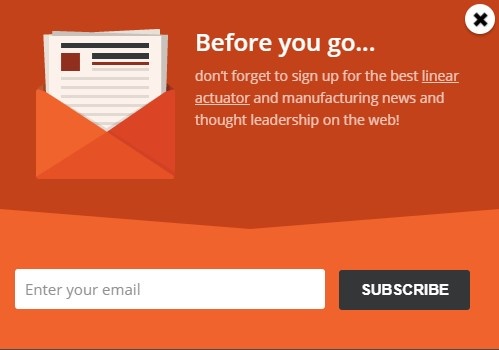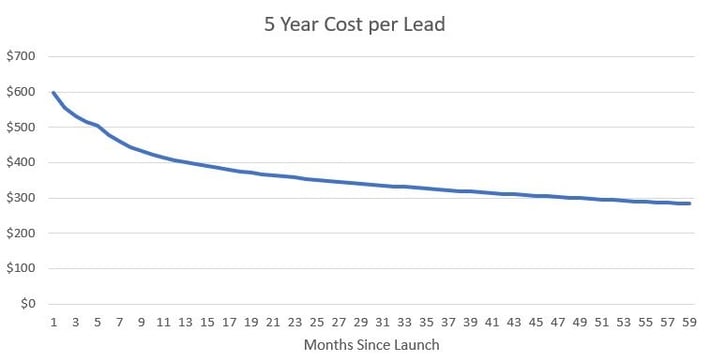It was late summer and Dave Publeesh, the CMO of Engtronica, was enjoying the last few days of his summer holiday. Despite his best efforts, his mind was already drifting to his next major marketing project.

The last twelve months had been good to Engtronica. The company was growing, as a resurgent economy and new growth in American manufacturing was driving demand for linear actuators. Dave’s marketing team had done their part, too. In addition to trade shows, banner ads and email campaigns, the team really knocked it out of the park with their weekly blog and monthly video series, a few of which had gone viral – as much as you can go viral in the world of linear actuators.
It was time to double-down. Dave had been reading and hearing about how the next major shift in content marketing would be for B2B companies to become their own publishers. Dave could already see the proof; Autodesk was gearing up to launch RedShift, while ARROW went about it by purchasing a handful of publications that summer.
Dave wanted Engtronica to be first into the breach for linear actuators.
Actuator World was born.
Today we’re going to do something a little different, and share a story with you about a (fictitious) marketing team and their path to becoming a publisher.
Here’s why.
Content marketing has matured to the point where several of its most ardent proponents have begun urging marketers to transition from mere practitioners of content marketing to become full-blown publishers. Such an evolution sounds sensible, but what are the real costs and returns? Most pundits don’t give those sorts of details—but those are exactly the details you need to make an informed decision.
As of this year, some 90% of B2B marketers are using content marketing, as confirmed by several independent studies including one published by this blog and a second from the minds at CMI & Marketing Profs. The argument for becoming a publisher is that in the face of thick competition, you can outmaneuver your opposition by overwhelming them in both content quantity and quality.
As a proposal, the strategy sounds great. One-up your competition, capture the white space, win the hearts and minds of your target audience, then profit. However, very few things are that simple, and business decisions shouldn’t come down to ‘sounds good,’ but rather the economic realities of the plan.
To that end, I’m going to tell you a story about Engtronica, a plucky linear actuator company that decided to heed the clarion call to become a publisher.
Now, Engtronica is entirely made up, but the numbers I’m going to apply to their publishing strategy are not. These numbers are informed by ENGINEERING.com’s own 5-year journey in the publishing space. By the end of this post, you’ll have everything you need to know about what it takes to make it as a publisher, and hopefully an answer as to whether it’ll work out if you go down the path to becoming a publisher yourself.
Let’s rejoin Dave after he and Engtronica in the Fall of 2016.
Pre-launch Planning and Costs for Becoming a B2B Publisher
Dave wanted Actuator World to be helpful, informative and include the best technical content in the industry. He wasn’t going to be able to run Actuator World given all his duties at Engtronica, so he needed someone capable of executing his vision. That person needed to have an entrepreneurial spirit, understand the B2B manufacturing space, and be capable of both writing content and managing a team of content producers.

The precise constellation of skills Dave wanted wasn’t found within his current marketing team and he wasn’t going to find it in the cadre of engineers who worked for Engtronica, so he decided to bring someone in from outside. Angela, was a project manager at the MegaContent Agency, and was familiar with Engtronica, having helped on several campaigns in the past. She also was well versed in the manufacturing space, having conducted content marketing for a handful of B2B manufacturers during her tenure at the agency. To get Angela onboard, Dave needed to pay her a competitive salary of $70k/year.
Angela would be running the show at Actuator World. She would be managing the marketing budget, executing and monitoring the media buys, managing internal marketing campaigns, hiring freelance authors, assigning them stories to write, conducting research (keyword and non-keyword) to determine what stories would have the best chance to drive traffic, editing content, directing her staff and so much more. She was also committed to leading by example, so would be publishing one article and one video herself each month.
To help Angela, they hired Terry, a plucky recent graduate of a journalism school who was a good fit because he had been subscribed to Popular Mechanics for 252 consecutive months and also liked to tinker with drones. He wasn’t an engineer himself, but he was technically minded and knew how to write. Terry was hired for $45,000 per year.
Terry would be responsible for authoring 4 stories each month. He would also be producing 1 video. Along with creating content he was going to be editing, publishing stories to the site, working behind the camera on video shoots and maintaining an active presence on social media for the publication.
That meant with the staff on hand, Actuator World was poised to produce 5 stories and 2 videos each month. They needed to be bigger than that if they were going to be a real publication, many of which produced daily content. Dave settled on a target of 12 stories and 2 videos every month – a new original story every other work day and a video every other week.
This meant they were going to need to source 7 stories from freelancers. They also needed a technical editor—someone with an engineering degree to ensure that what they were writing was completely correct. They decided they were going to look for these people on Upwork.com, the web’s most popular freelancing site.

Dave wanted well-written, thoroughly researched and technical content. This meant they couldn’t hire just anyone. After fielding some quotes, they determined they were going to need to pay $1,000 per article, $40 per technical edit and $50 per video edit. For the year, the costs were projected to be:
Freelancer writers, $84,000
Technical edits, $2,880
Video edits: $1,200
Total freelance costs: $88,080
Combined with the salaries of Angela and Terry the human resource costs for year one was projected to be: $203,080.
Actuator World had a team and a publishing plan. Next, it needed a site and a platform to build upon. This responsibility fell to Angela, with Terry to help her along. Having worked in content publishing, Angela knew their site needed an identity, a brand all its own that grabbed the attention of their audience before they read a single word. To do this, they needed to pay for a designer and development team to produce a custom WordPress theme and branding for the site. This was going to cost $15,000.
They also were going to need a domain URL, an email distribution list/database, a contact management system and monthly web development and upkeep. All together, this was budgeted under the pretty line item “Technology” in their business plan, and was projected to cost another $24,000 for the year.

Actuator World hadn’t published a single word, but had already accrued or committed to the following costs:
Pre-Launch Salaries (Angela and Terry) ¼ of year: $28,000
Startup Cost (WordPress theme): $15,000
Projected annual HR costs: $203,080
Projected Technology costs: $24,000
Running Total committed for the first year: $270,080
Launch
The runup to launch was madness. Since being brought on board in October, Angela and Terry had worked incredibly long hours to make sure that when the calendar flipped to January, Actuator World was ready to go. The hard work was worth it though. On January 9th, Actuator World went live.
The website was sleek, easy to navigate and unlike any other site seen in the uniform landscape of Manufacturing B2B websites. You knew you were looking at something really different—even cool.
The brain trust had also planned ahead, knowing they needed a full slate of content ready at launch. During the three months the site was being built, Angela and Terry had written their monthly allotment of articles for January, and had sourced the prescribed amount of content from their newly hired freelancers.
The old Engtronica blog saw around 1,000 page views per month on average. This traffic was presumed to carry over to the new venture. To supplement that traffic, Angela was going to purchase amplification services from Facebook, Twitter and LinkedIn. The blended price of this traffic was expected to be about $2 per visit—aggressively low for a B2B company. But they weren’t just another B2B company; they were a publisher now, and needed to act like it.

Actuator World wasn’t just some philanthropic enterprise for Dave and Engtronica. Yes, it was going to be a crown jewel for them; a living, breathing, functioning subsidiary of the parent company that they could crow about to their golf buddies or brag about at trade shows. That, however, was not the payoff – they payoff needed to be leads. Dave knew it. Angela knew it. They didn’t expect it to deliver from day one, but in the long term that’s how Actuator World would be judged.
The Puzzling Metrics of Publishing. What Happened to Our CPL?
Actuator World had been live for half a year. To those looking at the site from outside, it looked like a major victory. The site was pumping out great content on a monthly basis, and feedback from Engtronica customers both old and new was overwhelmingly positive. Because they were publishing actuator and manufacturing news, not just Engtronica news, other manufacturing news services had picked up and circulated some of their content. They also had a small, but burgeoning fan base across their social channels thanks to Terry’s activities.
From Dave and Angela’s perspective, things weren’t so rosy. Despite their traffic being more than 5x what it was from what the Engtronica blog had seen during the same period the previous summer, by the end of June they had only accumulated 372 new leads. The killer was their conversion rate.
When Dave had created his business plan for Actuator World, he had expected it to attract subscribers the way the Engtronica’s blog had, at a 4.31% conversion rate, placing them in the upper echelon of B2B sites. Actuator World was converting at a mere 1%. They had spent to date $187,940 to build the site, resulting in an average cost per lead of $501.
The team sat down to brainstorm about the results they were seeing. They started by looking at the leads they collected. Most looked liked what they had seen sourced from the old Engtronica blog: people in their core target customer set.
However, there were quite a few leads that left the team scratching their head. An aviation engineering professor from Germany. A retired army technician in California. A high school senior in Canada. And on it went.
They dug a level deeper into their analytics, tracing leads to their landing pages. The contacts that matched the personas they had planned for were coming in fairly evenly across all their content. The mismatch contacts, though, were coming in predominantly from thought leadership and general manufacturing interest pieces. More troubling was that these big picture articles were their most popular, garnering the highest rates of click-through and traffic.
Angela was the first to voice the obvious. Engtronica was a niche company, and their old blog wrote about very specific linear actuator topics to an audience that was for the most part familiar with the company and its products. A great many of their subscribers only learned of the blog after venturing to the Engtronica site to learn about their products. These audience members were already primed to become subscribers.
The new visitors were different. Many were coming to Actuator World for the first time, and weren’t familiar with the brand. They were also coming because the new stories had appeal outside of Engtronica’s core audience. Everyone who had previously read the Engtronica blog would want to read the content of Actuator World; but so, too, would people interested in advanced manufacturing, Industry 4.0 and collaborative robots.
The team decided they wanted to keep their editorial direction. If an engineer was interested in collaborative robots or the winning processes of modern manufacturers, then it was likely they could be a potential customer for Engtronica one day.
What they decided to do different was be a little more aggressive in attracting signups. If someone scrolled ¾ of the way through an article, then on exit they’d be greeted with a message: “Before you go, don’t forget to sign up for the best linear actuator and manufacturing news and thought leadership on the web!” They also put in place some tiered content, where users could download a related whitepaper by providing their email address.

Conversion Rate for Publishing is Lower than the Brand Web Site, and Always Will Be
The year was closing, and Dave and Angela needed to take stock of how far they’d come and how far they were going to be able to go. Since their interventions in June, things had improved. They were seeing far fewer misaligned contacts on account of them highlighting the concept of providing the “best linear actuator” news and thought leadership on the web.
They had seen conversion improve by 25%, and traffic was still moving upwards. In their first month they had spent $598 to acquire their first few leads; that June it was down to $501, and now stood at $411. That wasn’t too bad, but it was a far cry from the roughly fifty dollars Engtronica was used to paying for leads. Dave decided that what they needed was a model, so he and Angela opened up Excel, and got to work.
They wanted to see what would happen over the next five years. They built in all of their costs and their growth rates, then took a look:
After five years, with static growth rates, conversions rates and costs, their CPL at year five was going to be $281. Their hearts sank. What could they do?

Angela wondered, what if the problem wasn’t the content, but that their sunk costs were too high? If they ramped up their purchased traffic, they could spread out the sunk costs amongst an even larger pool of leads. Dave was excited. He said, lets triple the traffic and see what happens. They adjusted the model, and five years out their cost per lead would equal…$213.
What if they went crazy, though, and purchased 1,000,000 visits a month, they wondered? It wasn’t going to happen, but as a thought experiment, it would give them their floor. $158. Ouch.
They still weren’t where they needed to be, and traffic wasn’t the only problem. They were worried because conversion rates are a tricky thing, especially for blog subscriptions. Sure, they could add more downloadable content or gate some of their best performing pages, but how much would that help?
They thought it was probably a pipe dream, but wanted to see what would happen if they were able to double their conversion rate. Infinite traffic, a doubled conversion rate and five years later—surely that had to work.
They plugged in the numbers: CPL still sat at $104, more than twice as expensive as their target, in what they felt was a better than best case scenario.

This was a tough chart to look at. The incremental reduction in cost was very flat starting around year 3. Actuator World was a major success and a major failure, all at the same time. People loved it and admired it, but it wasn’t and likely never would reach it’s internal KPI goal. Dave and Angela looked at each other and wondered what to do next.
The slam dunk Dave thought he had cooked up two summers previous looked an awful lot worse in the cold light of winter at the end of year one. The only thing Dave was certain of at this point was that being a publisher wasn’t the easy path to dirt cheap and easy leads.
If you want to play with Dave and Angela’s spread sheet, you can do by clicking here. We had a lot of fun telling this story, and we hope you enjoyed reading it. Please let us know what you’d do if you were the Actuator World team in the comments.






